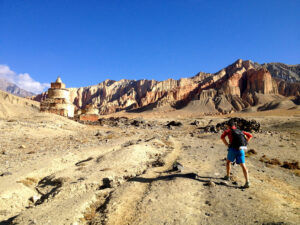Regardless of sport, all athletes must cross metaphorical rivers which represent the one experience, the one feeling, the one thought, the one focus of awareness that is central to every athlete’s experience: the pain through which we must all suffer. For to be an athlete is to know pain, and through pain we know suffering. And by crossing that river of pain, we come to know victory of the body and of spirit.
Our rivers may be crossed by pedaling or paddling, by running or crawling, by pushing or pulling, by swimming or surfing, by digging under or jumping over, or sometimes by circumventing circuitously. But in sport as in life, the best way out is through, so through the river of pain we must go in order to get to the other side. Finish lines, and sometimes transcendence, await us there.
For many athletes, pain is the source of unhappiness, of dismay, of defeat. It’s the reason for slowing down, for backing off, for going easy, for going home. Pain challenges every one of us without discrimination or prejudice, for it is the great universal of athletics. And thus suffering is the day-to-day common denominator of all athletes.
It is this suffering that unites us, teaches us, ennobles us. Through many long hours of suffering, we learn to rise to the occasion as we battle “higher, faster, further” in a continual march of athletic expression.
The secret is to see beyond the pain and push ahead, regardless of how we feel. We do this by looking beyond the point of pain to that place where it does not impede our progress, does not slow us down, does not matter. In that place, pain is purely perception, a self-limiting mechanism for failure. In a society of victims, pain is a cop-out. But for an army of truth-seeking athletes, pain is the drill sergeant.
When the pain doesn’t matter, when we can live with it, then we are unstoppable. And then, as unflagging, unyielding life-forces, we are champions of the inner and outer universes.
There is one important caveat here: The wise and noble athlete always pays the utmost attention to pain in one important way, which is to determine if it will cause serious injury. It takes time, trial, and error to learn to know the very real distinction between damaging pain and purely painful pain. Trust your instincts, not your ego here. Seek professional advice. And always, well, almost always, err on the side of prudence. DNF beats CPR, every time.
(Personally, I make a distinction between muscular pain and joint pain, for example. Muscles usually feel better as soon as you stop, while joints can take a long time. For an important race, I’m willing to allow up to a month to recover from the abuse. That’s where I draw my line in the sand.)
If the decision is made that pain is non-injurious, but rather simply disturbing, then go into the pain. Getting to the other side, well, that takes time, patience, and practice. You don’t just snap your fingers and make it go away after reading one article.
Finally, don’t judge the pain. Don’t take it personally. Don’t get angry about it. Don’t get attached to it. Pain is like the weather; it’s just busy being itself, without concern for how it affects our day. Everyone’s feeling it, so just forget about it, breathe, and enjoy what you’re doing instead. Focus on both the process and on the goal of what you’re doing. Put your heart and soul into getting to the finish line and, most importantly, enjoying yourself along the way. En route, you can relish the territory you are covering, the pleasure of movement, and the joy of being in control. Across that river lies your finest destiny, after all.
Sidebar 1: Tools for Transcending
Desire: You must really want the goal that you are working to attain. Wanting overcomes almost everything.
Pleasure: You have to really enjoy, in fact, love, the act and the process of what you are doing. The Beatles had it right: “Love is all you need.”
Happy stomach / Happy thoughts: Nutrition dictates brain chemistry, so you have to be eating right, and consistently, in order to think and manipulate both your body and brain.
Game Plan: Enter every race or workout with well-defined goals on a sliding scale For example, to finish, to go faster than before, to place top five, to win.
Experience: Several years of far-flung experience in the world of outdoor athletics will render you ever-adaptable and ever-comfortable. Little or nothing will scare you. It’s not beginner’s luck that’s helpful; it’s veteran’s experience.
Expertise: A really strong background in a singular athletic pursuit will give you an edge, or at least an amount of confidence, not only in that sport but in others, too. Plus there is a universalness to outdoor athletics that transcends the imaginary barriers between different sports.
Wisdom: It can grant patience, preparedness, nutritional know-how, savviness of your body’s finer workings, and even biomechanical and ergonomic shrewdness. Once again, it comes with time invested in regular training and racing done with a high level of awareness.
Sidebar 2: Techniques for Getting Through
Lively Breathing: Focus on your breath. Let it be relaxed, efficient, and powerful, literally inspiring you with energy. Depending on the intensity of what you’re doing at the moment, perhaps you can breathe in and out through the nose only, even using Ujjayi breathing as in yoga.
Supple Posture: Relax! Line your body up properly for the activity you are doing. Only perfect practice makes perfect.
Form Focus: Break things down, body part by body part, and relax each one of them. Remove energy blockages and tightnesses that can cause injury or discomfort. Be certain that you are moving and working with your body in the most efficient and effective manner.
Observe and Enjoy: Regularly take a moment and actually notice where you are and what you are doing. Appreciate it. Find something unique about your environment to enjoy.
Count Blessings: Remember, while you and five, or a hundred, or a thousand of your fellow competitors are out there doing what you’re doing, the rest of the six billion inhabitants of the planet are probably less happy and less fortunate than you are in that particular moment. Many of our fellow athletes are injured or sick or battling disease; think how much they wish they could trade places with you.
Reflect: Retrace your steps in the race and see how far you’ve come. Picture mental snapshots of the event as it has unfolded and see yourself overcoming the obstacles that have been in your path. Let these recent memories empower you to continue boldly.
Feel the Kindred Spirit: Think about your comrades who are out there with you, each experiencing the same event differently in the details, but the same in the big picture. Of course, remember, if they can do it, then so can you! Appreciate and respect their efforts, as they do yours. “Brothers in arms” are we.
Predict: Mentally trace your route ahead in the event. See, in your mind’s eye, where you’re headed. Plan ahead. Don’t get caught by surprise.
Sidebar 3: Pain and Suffering: A Flowchart for Crossing the River
Get Out There and start to exert yourself.
Go long or go hard or both.
Begin to experience pain.
As you go further and/or harder, the pain increases.
The pain starts to annoy you.
You assess the pain: is it injurious?
If no, then you make a conscious decision to accept the pain.
You don’t mind the pain.
You don’t care about the pain.
You are not attached to the pain.
Finally, you accept the pain.
The pain just is.
After acceptance, you realize that the pain doesn’t matter.
Without it mattering, it can’t contain or control you.
You have transcended the pain.
Now you can do anything.
Here’s the critical part: As you go further or harder, the cycle can either be repeated, or not.
You decide.
It’s your pain.
Go with it.
- By Chris Kostman. Originally published in MultiSPORT Magazine, Sweden, premier issue, April 1999, and later in Endurance News, #60, October 2008




